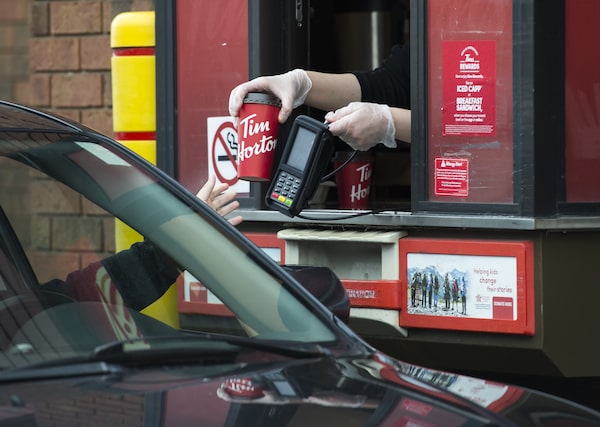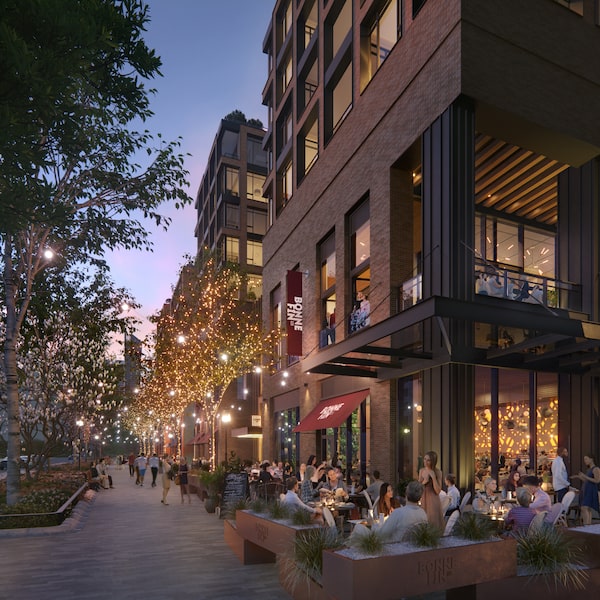
Many retail and food outlets have modified their parking lots and lanes amid the COVID-19 pandemic.Nathan Denette/The Canadian Press
When the COVID-19 pandemic was declared in March, 2020, experts predicted a revival of drive-in movies and a major shift by retailers to build drive-through and curbside pickup facilities.
Although the shift is not as big as some retailers expected, there are signs of change that will likely be long-lasting.
A survey conducted by McKinsey and Company found that last summer, 23 per cent of Canadians said they used drive-through restaurant service either for the first time or more than before the pandemic, 18 per cent did the same for curbside meal pickup and 27 per cent went to curbside locations to pick up goods they ordered online.
Meanwhile, many retail and food outlets have modified their parking lots and lanes, and there are still 37 drive-in theatres in Canada.
This summer, you can pull up the minivan to the Starlite Drive-in, in Stoney Creek, Ont., and choose from among three double features. There are also special film events, such as drive-in movies at Ontario Place in Toronto, which opened in 2020 and earlier this summer in response to pandemic indoor theatre closures.
Elsewhere there are sparks of drive-in creativity. In Amenia, N.Y., for example, about an hour north of New York City, a retro-facility called Four Brothers Drive-in welcomes not only cars, but also overnight campers and walk-ins who can bring chairs and blankets and enjoy movies under the stars.
In Vaughan, Ont., north of Toronto, SmartCentres launched a summer series of free drive-in movies every Thursday and Saturday through September at ArtWalk, as part of SmartVMC, a 100-acre planned city centre site being developed at the Vaughan Metropolitan Centre near the northernmost TTC subway station. The SmartCentres site also has food trucks and 30,000 square feet of Instagram-friendly mural art.
The goal of the movies and the art is not to be car-friendly or COVID-19-safe, though the site is both, says Mandy Mail, vice-president of marketing for SmartCentres, but to create an attractive destination in advance of a development of four mixed-use buildings and a nine-acre park, slated to be built this decade.
“We’re creating the destination in advance for people to enjoy, and we’re making it art-inspired,” Ms. Mail says.
It’s another example of how, while developers have acted quickly to come up with pandemic-era drive-through facilities, it’s not really a cohesive trend. People idle their engines at drive-throughs for their double-doubles and lattes, but they did that before the pandemic, too.
As lockdowns start to ease and people drift back into stores, restaurants and cinemas, the move toward more widespread drive-in business is turning out to be more of an adjustment than a stampede, says Jonathan Gitlin, chief executive officer at RioCan Real Estate Investment Trust.
Nevertheless, “going forward, we think that some of this change is here to stay,” he adds. The McKinsey study found that 70 per cent of Canadians who tried a new shopping method since the pandemic say they intend to continue it after restrictions are lifted.
Retail and commercial developers are finding that they need to accommodate people who don’t want to go inside. Since early 2020, RioCan has set up designated curbside pickup parking spots in its malls, and retailers have set up systems for motorists to phone or text and have merchandise loaded into their cars.
Even such subtle changes are a major undertaking for a company such as RioCan, which owns 289 properties, most of them retail/commercial, with 44 million square feet of leasable space.
“When the pandemic started, we recognized that our customers, who are our tenants, needed to enable people to shop without coming into stores,” Mr. Gitlin says. “We had to change our parking lot configurations [to] set up spaces for people collecting goods.”
“We’ve learned during COVID that consumers like having some control over the goods they purchase, which they don’t always have when they have something delivered to their homes,” he adds.
“On the other hand, during COVID they didn’t necessarily want to go into stores. We think bringing things to them in their cars is a trend that has legs,” he says. “This is despite noticing that many people began lining up at shops when governments okayed indoor shopping a few weeks ago.”
According to Poughkeepsie, N.Y.-based developer Eric Baxter, COVID-19 did not affect retail and restaurant patterns in the semi-rural region as much as in bigger cities.
“We built a local coffee shop that includes drive-through and in-store pickup and a number of outdoor tables, but these are features that were planned before COVID happened,” Mr. Baxter says.
“These were always part of a long-term trend, but for retail developers, the pandemic may have sped up the timeline a bit. But I haven’t seen a lot of evidence of developers saying that COVID has changed things forever in the way they design buildings,” he adds.
At the same time, developers say that they’re anxious to design and build projects that don’t cater to car culture the way earlier malls and food stands did.
“You can drive to ArtWalk, but we also want people to come on the subway, on their bikes and on foot,” Ms. Mail says about the new Vaughan food and movie destination.
“Here, we’re actually seeing zoning that eliminates the allowance for drive-throughs. In the future, people may look at our cities and ask why we configured everything just for cars,” Mr. Baxter says.
Mr. Baxter, Mr. Gitlin and Ms. Mail agree that if there’s any trend, it’s less toward drive-throughs and curbside service and more toward expanding outdoor dining space.
“We’re learning how much people love being outdoors,” Mr. Baxter says.

The Well is a mixed-used project under way on King Street West in Toronto.handout
In fact, Mr. Gitlin says, one lesson the pandemic has taught us is that people like being outside so much that designers are conceiving projects that blur the distinction between being inside and outside the building.
He points to The Well, a mixed-used project under way on King Street West in Toronto. The RioCan/Allied Properties Real Estate Investment Trust development is designed to create a seamlessness between indoors and outdoors.
Whether people walk in, drive up or get served outside, the goal is the same, and it’s one that the pandemic has reinforced, Mr. Gitlin says.
“We want people to come to a place where they feel comfortable and safe.”